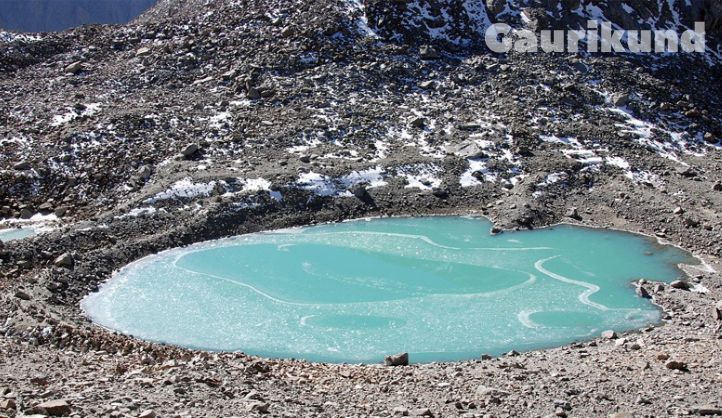About Gaurikund:
- Geographical Location:
- Gaurikund is situated in the Rudraprayag district of Uttarakhand, India, within the Garhwal region of the Himalayas.
- Altitude:
- Positioned at an elevation of approximately 1,982 meters (6,503 feet) above sea level, Gaurikund is a town with a high-altitude setting.
- Pilgrimage Significance:
- Gaurikund holds immense religious significance as the starting point for the trek to the revered Kedarnath temple, one of the twelve Jyotirlingas dedicated to Lord Shiva.
- Mythological Association:
- According to Hindu mythology, Gaurikund is believed to be the place where Goddess Parvati, also known as Gauri, performed penance to win the favor of Lord Shiva.
History of Gaurikund:
- Ancient Roots:
- The history of Gaurikund is deeply rooted in ancient times, with its significance documented in Hindu scriptures and legends.
- Religious Traditions:
- Over the centuries, Gaurikund has been a part of religious traditions and pilgrimage routes, witnessing the footsteps of countless devotees.
- Cultural Heritage:
- The town’s history is intertwined with the cultural heritage of the region, reflecting the spiritual and historical tapestry of Uttarakhand.
Why Gaurikund is Famous:
- Pilgrim’s Gateway:
- Gaurikund is famous as the gateway for pilgrims embarking on the Char Dham Yatra, specifically for the trek to Kedarnath.
- Goddess Parvati Temple:
- The presence of the Goddess Parvati temple adds to Gaurikund’s fame, drawing devotees who seek blessings before commencing the challenging trek.
- Spiritual Aura:
- The town is renowned for its spiritual aura, serving as a place of reverence and reflection for those beginning their sacred journey.
Things to Do in Gaurikund:
- Visit Goddess Parvati Temple:
- Explore the Goddess Parvati temple in Gaurikund, paying homage to the deity and seeking blessings for a safe and auspicious journey.
- Start the Kedarnath Trek:
- Gaurikund is the starting point for the trek to Kedarnath. Engage in the trek, experiencing the scenic beauty and spiritual significance along the way.
- Dip in Hot Springs:
- Gaurikund is known for its hot springs. Pilgrims often take a dip in the thermal waters, considering it purifying before the pilgrimage.
- Experience Local Culture:
- Immerse yourself in the local culture of Gaurikund, interacting with residents, participating in rituals, and gaining insights into the traditions of the region.
- Scenic Views:
- Enjoy the breathtaking views of the surrounding Himalayan landscapes, making Gaurikund not just a spiritual destination but also a place of natural beauty.
Things to Know about Gaurikund:
- Geographical Location:
- Gaurikund is located in the Rudraprayag district of Uttarakhand, India, nestled in the Garhwal region of the Himalayas.
- Altitude:
- Positioned at an altitude of approximately 1,982 meters (6,503 feet) above sea level, Gaurikund offers a high-altitude setting.
- Pilgrimage Importance:
- Gaurikund is a significant pilgrimage site, serving as the starting point for the trek to Kedarnath, a revered temple dedicated to Lord Shiva.
- Mythological Connection:
- According to Hindu mythology, Gaurikund is associated with Goddess Parvati’s penance to win Lord Shiva’s favor.
How to Reach Gaurikund:
- By Air:
- The nearest airport is Jolly Grant Airport in Dehradun, approximately 236 kilometers away. From the airport, one can hire a taxi or use public transportation to reach Gaurikund.
- By Rail:
- The closest railway station is Rishikesh Railway Station, around 215 kilometers away. From Rishikesh, one can travel by road to reach Gaurikund.
- By Road:
- Gaurikund is well-connected by road to major towns and cities in Uttarakhand. Regular buses and taxis operate on the route, providing transportation options.
- Trekking from Sonprayag:
- Sonprayag is the last motorable point before Gaurikund. From Sonprayag, pilgrims often continue the journey on foot, trekking to Gaurikund.
Travel Tips for Gaurikund:
- Pilgrimage Preparedness:
- If undertaking the Char Dham Yatra, ensure proper preparation with essentials such as permits, comfortable clothing, and suitable footwear for trekking.
- Altitude Acclimatization:
- Gaurikund is at a considerable altitude. Take breaks during the trek to acclimatize gradually, reducing the risk of altitude-related issues.
- Weather Awareness:
- Check the weather conditions before traveling, especially during the monsoon season, when rainfall can affect road conditions and trekking trails.
- Accommodation Reservations:
- Gaurikund offers accommodations, but during peak pilgrimage seasons, it’s advisable to book in advance to secure a place to stay.
Best Time to Visit Gaurikund:
- Summer (May to June):
- Ideal for pilgrimage and trekking, with pleasant weather and clear skies facilitating a comfortable journey.
- Post-Monsoon (September to November):
- Another favorable time with clear views, suitable for pilgrimage and outdoor activities.
- Winter (December to March):
- While winter transforms the region into a snowy landscape, travel can be challenging, and facilities may be limited.
Places to Eat Near Gaurikund:
- Local Eateries in Gaurikund:
- Explore the local eateries in Gaurikund, offering authentic regional cuisine. These establishments often serve simple yet nourishing meals for pilgrims and travelers.
- Sonprayag Food Stalls:
- Sonprayag, being the last motorable point, may have food stalls offering quick bites and refreshments for those heading towards Gaurikund.
- Chai Stalls on Trekking Route:
- Along the trekking route from Sonprayag to Gaurikund, chai stalls provide opportunities to rest and enjoy a cup of tea while taking in the scenic surroundings.
- Simple Dhabas:
- Dhabas (roadside eateries) near Gaurikund may offer homely meals, including dal, rice, and local specialties, catering to the dietary needs of trekkers and pilgrims.
- Gaurikund Temple Prasad:
- The temple in Gaurikund may offer prasad (religious offerings) that pilgrims often partake in, experiencing the spiritual essence along with sustenance.
Nearby Places Gaurikund:
- Sonprayag:
- Sonprayag is a nearby location and the last accessible point by road. Pilgrims often pass through Sonprayag on their way to Gaurikund.
- Triyuginarayan Temple:
- The Triyuginarayan Temple, linked to the marriage of Lord Shiva and Goddess Parvati, is in proximity to Gaurikund and is a significant pilgrimage site.
- Kedarnath:
- Kedarnath, the final destination of the trek from Gaurikund, is a sacred town with the renowned Kedarnath temple dedicated to Lord Shiva.
- Vasuki Tal:
- Vasuki Tal, a high-altitude lake, is a trekking destination near Gaurikund, offering mesmerizing views of the surrounding peaks.
- Rudraprayag:
- Rudraprayag, a town at the confluence of the Alaknanda and Mandakini rivers, is a nearby place with spiritual significance and natural beauty.
Conclusion for Gaurikund:
In conclusion, Gaurikund serves as a pivotal point for pilgrims and trekkers embarking on the spiritual journey to Kedarnath. Surrounded by scenic landscapes and with nearby places of cultural and natural importance, Gaurikund stands as a testament to the rich tapestry of spirituality and beauty in the Himalayan region.
Frequently Asked Questions (FAQs) about Gaurikund:
Q: What is the significance of Gaurikund in Hindu mythology?
A: Gaurikund is believed to be the place where Goddess Parvati performed penance to win Lord Shiva’s favor, adding to its mythological importance.
Q: How far is Gaurikund from Kedarnath?
A: Gaurikund is the starting point of the trek to Kedarnath and is approximately 14 kilometers away from Kedarnath.
Q: Are there accommodation options in Gaurikund?
A: Gaurikund offers various accommodation options, including guesthouses and dharamshalas, catering to the needs of pilgrims and travelers.
Q: Can Gaurikund be visited throughout the year?
A: While the trek to Kedarnath is challenging in winter, Gaurikund can be visited during the pilgrimage season from May to November.
Q: What are the safety precautions for the trek from Gaurikund to Kedarnath?
A: Trekkers should acclimatize properly, carry essentials, check weather conditions, and undertake the trek with a gradual pace to ensure safety.









